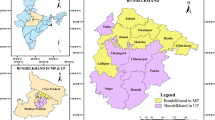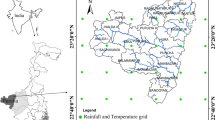Abstract
Drought is a climatic phenomenon that can occur in various regions with different climate conditions. Generally, drought has negative impacts on different fields such as environment, rangelands, and water resources. The agricultural section (especially rain-fed agriculture) is one of the parts that is directly affected by different types of drought especially meteorological and agricultural droughts. The standardized precipitation evapotranspiration index (SPEI) is one of the newest and most applied indices to assess drought characteristics. In this paper, a modification is suggested for SPEI with the substitution of observed precipitation (OP) with effective precipitation (EP) to evaluate drought, with an emphasis on consideration of drought effects on agricultural section. To calculate EP, Food and Agriculture Organization of the united nation method (FAO), US Bureau of Reclamation (USBR), the Simplified version of Soil Conservation Service of the US Department of Agriculture method (USDA-SCS simplified), and the CROPWAT version of USDA-SCS method (USDA-SCS CROPWAT) were used. To compare the calculated SPEI based on OP (SPEIOP) and EP (SPEIEP) (based on different EP calculation methods), the correlation coefficients (CC) between SPEIOP and SPEIEP in four synoptic stations with at least 30 years of climatic data and annual yield loss (%) in winter wheat (Triticum sativum) (simulated using AquaCrop model) in the suitable reference periods for agricultural drought were used. Results showed, in Fasa, Drodzan, and Zarghan stations, the CC between SPEI based on EP using the USBR method (SPEIUSBR) and annual YL% had the highest values (in 42.11%, 68.42%, and 36.84% of Triticum sativum all reference periods, respectively). In Shiraz station, the CC between SPEI based on EP using the FAO method (SPEIFAO) and annual YL% had the highest values (in 47.37% of all reference periods). In all stations, the SPEIUSBR had the most reference periods with significant CC at 0.05 or 0.01 levels.






Similar content being viewed by others
References
Adnan S, Ullah K, Shuanglin L, Gao S, Khan AH, Mahmood R (2018) Comparison of various drought indices to monitor drought status in Pakistan. Clim Dyn 51(5–6):1885–1899
Aguirre A, Río MD, Condés S (2018) Intra- and inter-specific variation of the maximum size-density relationship along an aridity gradient in Iberian pinewoods. For Ecol Manag 411:90–100
Ahani H, Kherad M, Kousari MR, Roosmalen LV, Aryanfar R, Hoseine SM (2012) Non-parametric trend analysis of the aridity index for three large arid and semi-arid basins in Iran. Theor Appl Climatol 112:553–564
Ahmad MI, Sinclair CD, Werritty A (1988) Log-logistic flood frequency analysis. Journal of Hydrology 98(3–4):205–224
Allen RG, Pereira LS, Raes D, Smith M (1998) Crop evapotranspiration. Guidelines for computing crop water requirements, FAO irrigation and drainage paper 56. FAO, Roma
Bahadori A, Sepaskhah AR (2012) Evaluation of the effects of different water management on winter wheat crop in the Bajgah and downstream of the Dorodzan dam using AquaCrop and CropSyst models, MSc thesis, Shiraz University
Beguería S, Vicente-Serrano SM, Reig F, Latorre B (2014) Standardized precipitation evapotranspiration index (SPEI) revisited: parameter fitting, evapotranspiration models, tools, datasets and drought monitoring. Int J Climatol 34(10):3001–3023
Brouwer C, Heibloem M (1986) Irrigation water management: irrigation water needs. Training manual no. 3. FAO, Rome
De Martonne E (1926) Aérisme et indice d’aridité. C R Acad Sci 182:1395–1398
Ebrahimpour M, Rahimi J, Nikkhah A, Bazrafshan J (2014) Monitoring agricultural drought using the standardized effective precipitation index. J Irrig Drain Eng 141(1):04014044
Garcia PM, Nicolas AL, Velazquez MP (2017) Combined use of relative drought indices to analyze climate change impact on meteorological and hydrological droughts in a Mediterranean basin. J Hydrol 554:292–305
Gidey E, Dikinya O, Sebego R, Segosebe E, Zenebe A (2018) Analysis of the long-term agricultural drought onset, cessation, duration, frequency, severity and spatial extent using Vegetation Health Index (VHI) in Raya and its environs, Northern Ethiopia. Environmental Systems Research 7(1):13. https://doi.org/10.1186/s40068-018-0115-z
Haro-Monteagudo D, Daccache D, Knox J (2017) Exploring the utility of drought indicators to assess climate risks to agricultural productivity in a humid climate. Hydrol Res 49(2):539–551. https://doi.org/10.2166/nh.2017.010
Hess T (2010) Estimating green water footprints in a temperate environment. Water 2(3):351–362
Jia Y, Zhang B, Ma B (2018) Daily SPEI reveals long-term change in drought characteristics in Southwest China. Chin Geogr Sci 28(4):680–693. https://doi.org/10.1007/s11769-018-0973-3
Kourgialas NN, Karatzas GP, Morianou G (2015) Water management plan for olive orchards in a semi-mountainous area of Crete, Greece. Glob Nest J 17(1):72–81
Liu X, Pan Y, Zhu X, Yang T, Bai J, Sun Z (2018) Drought evolution and its impact on the crop yield in the North China Plain. J Hydrol 564:985–996
Liyan T, Shanshui Y, Steven MQ (2018) Evaluation of six indices for monitoring agricultural drought in the south-central United States. Agric For Meteorol 249:107–119
Mahdavi M (2002) Applied hydrology, Tehran university press, 2, p.437
Mathieu JA, Aires F (2018) Assessment of the Agroclimatic indices to improve crop yield forecasting. Agric For Meteorol 253-254:15–30
McKee TB, Doesken NJ, Kleist J (1993) The relationship of drought frequency and duration to time scales. In: Proc. 8th Conf. on Applied Climatology, 17–22 January, American Meteorological Society, Mass, 179–184
Mousavizadeh SF, Honar T, Ahmadi SH (2016) Assessment of the AquaCrop model for simulating canola under different irrigation managements in a semiarid area. Int J Plant Prod 10(4):425–446
Peng Y, Jun X, Yongyong Z, Chesheng Z, Yunfeng Q (2018) Comprehensive assessment of drought risk in the arid region of Northwest China based on the global palmer drought severity index gridded data. Sci Total Environ 627:951–962. https://doi.org/10.1016/j.scitotenv.2018.01.234
Prabnakorn S, Maskey S, Suryadi FX, De Fraiture C (2018) Rice yield in response to climate trends and drought index in the Mun River Basin, Thailand. Sci Total Environ 621:108–119
Rezaei Banafsheh M, Rezaei A, Faridpour M (2015) Analyzing agricultural drought in east Azarbaijan province emphasizing remote sensing technique and vegetation condition index. Water and Soil Science (Agricultural Science) 25(1):113–123
Sadras VO, Cassman KGG, Grassini P, Hall AJ, Bastiaanssen WGM, Laborte AG, Milne AE, Sileshi G, Steduto P (2015) Yield gap analysis of field crops—methods and case studies. FAO and DWFI - FAO Water Reports No. 41, Rome, Italy
Salemi H, Soom MAM, Lee TS, Mousavi SF, Ganji A, Yusoff MK (2011) Application of AquaCrop model in deficit irrigation management of winter wheat in arid region. Afr J Agric Res 6(10):2204–2215
Shamsnia SA, Pirmoradian N (2013) Simulation of Rainfed wheat yield response to climatic fluctuations using model (case study: shiraz region in southern of Iran). Int J Eng Sci Invention 2(5):51–56
Shirshahi F, Babazadeh H, Ebrahimipak N, Zeraatkish Y (2018) Calibration and assessment of AquaCrop model for managing the quantity and time of applying wheat deficit irrigation. Irrigation Sciences and Engineering 4(1):31–44
Sisi W, Xingguo M, Shi H, Suxia L, Zhengjia L (2018) Assessment of droughts and wheat yield loss on the North China Plain with an aggregate drought index (ADI) approach. Ecol Indic 87:107–116
Soh YW, Koo CH, Huang YF, Fung KF (2018) Application of artificial intelligence models for the prediction of standardized precipitation evapotranspiration index (SPEI) at Langat River Basin, Malaysia. Comput Electron Agric 144:164–173. https://doi.org/10.1016/j.compag.2017.12.002
Stamm GG (1967) Problems and procedures in determining water supply requirements for irrigation projects. In: Hagan et al (eds) Irrigation of agricultural lands. Agronomy Monograph 11. American Society of Agronomy, Madison, pp 771–784
Tajbakhsh S, Eisakhani N, Fazl Kazemi A (2015) Assessment of meteorological drought in Iran using standardized precipitation and evapotranspiration index (SPEI). Journal of the Earth and Space Physics 41(2):313–321
Tigkas D, Vangelis H, Tsakiris G (2016) Introducing a modified reconnaissance drought index (RDIe) incorporating effective precipitation. Procedia Engineering 162:332–339
Tigkas D, Vangelis H, Tsakiris G (2018) Drought characterization based on an agriculture-oriented standardized precipitation index. Theor Appl Climatol 135:1435–1447. https://doi.org/10.1007/s00704-018-2451-3
Tsakiris G, Pangalou D, Vangelis H (2007) Regional drought assessment based on reconnaissance drought index (RDI). Water Resour Manag 21(5):821–833
USDA SCS (1970) Irrigation water requirements. United States Department of Agriculture, soil conservation service, tech. Rel. No 21, (rev. 1970), 88p
Vicente-Serrano SM, Beguer’ıa S, Lopez-Moreno JI (2010) A multi-scalar drought index sensitive to global warming: the standardized precipitation evapotranspiration index – SPEI. J Clim 23:1696–1718
Vicente-Serrano SM, Begueria S, Lorenzo-Lacruz J, Julio CJ, Lopez-Moreno JI, Azorin-Molina C, Revuelto J, Morán-Tejeda E, Sanchez-Lorenzo A (2012) Performance of drought indices for ecological, agricultural, and hydrological applications. Earth Interact 16:1–27
Virgílio AB, Gouveia CM, DaCamara CC, Trigo IF (2018) A climatological assessment of drought impact on vegetation health index. Agric For Meteorol 259:286–295
Wable PS, Jha MK, Shekhar A (2018) Comparison of drought indices in a semi-Arid River Basin of India. Water Resour Manag 33:1–28. https://doi.org/10.1007/s11269-018-2089-z
Xu HJ, Wang XP, Zhao CY, Yang XM (2018) Diverse responses of vegetation growth to meteorological drought across climate zones and land biomes in northern China from 1981 to 2014. Agric For Meteorol 262:1–13
Zamaniyan MT, Behyar MB, Karimi HA, Vazifedoust M (2012) Agricultural drought monitoring and analysis using remotely sensed data from NOAA-AVHRR. Journal of Climate Research 3(9):102–103
Zand-Parsa SH, Parvizi S, Sepaskhah AR, Mahbod M (2016) Evaluation of simulated soil water content, dry matter and grain yield of winter wheat (cv. Shiraz) using WSM and AquaCrop models. JWSS 20(77):59–70 (In Persian)
Zare Abyaneh H, Ghabaei SM, Mosaedi A (2015) Drought monitoring based on standardized precipitation evapotranspiration index (SPEI) under the effect of climate change. Journal of Water and Soil 29(2):384–392
Zarei AR (2018) Evaluation of drought condition in arid and semi- arid regions, using RDI index. Water Resour Manag 32:1689–1711. https://doi.org/10.1007/s11269-017-1898-9
Zarei AR, Mahmoudi MR (2017) Evaluation of changes in RDIst index effected by different potential evapotranspiration calculation methods. Water Resour Manag 31(15):4981–4999
Zarei AR, Moghimi MM (2017) Environmental assessment of semi-humid and humid regions based on modelling and forecasting of changes in monthly temperature. Int J Environ Sci Technol. https://doi.org/10.1007/s13762-017-1600-z
Zarei AR, Zare S, Parsamehr AH (2015) Comparison of several methods to estimate reference evapotranspiration. West Afr J App Ecol 23:17–25
Zarei AR, Shabani A, Mahmoudi MR (2019) Comparison of the climate indices based on the relationship between yield loss of rain-fed winter wheat and changes of climate indices using GEE model. Sci Total Environ 661:711–722
Zareiee AR (2014) Evaluation of changes in different climates of Iran, using De-Martonne index and Mann-Kendall trend test, natural hazards and earth system science. Discuss 2:2245–2261
Zuo D, Cai S, Xu Z, Li F, Sun W, Yang X, Kan G, Liu P (2018) Spatiotemporal patterns of drought at various time scales in Shandong Province of Eastern China. Theor Appl Climatol 131(1–2):271–284. https://doi.org/10.1007/s00704-016-1969-5
Acknowledgments
Authors of this paper would like to thank the national meteorological organization of Iran (www.irimo.ir) and water meteorological organization of Fars province for providing the necessary meteorological information.
Author information
Authors and Affiliations
Corresponding author
Ethics declarations
Conflict of interest
The authors declare that they have no conflict of interest.
Rights and permissions
About this article
Cite this article
Zarei, A.R., Moghimi, M.M. Modified version for SPEI to evaluate and modeling the agricultural drought severity. Int J Biometeorol 63, 911–925 (2019). https://doi.org/10.1007/s00484-019-01704-2
Received:
Revised:
Accepted:
Published:
Issue Date:
DOI: https://doi.org/10.1007/s00484-019-01704-2




